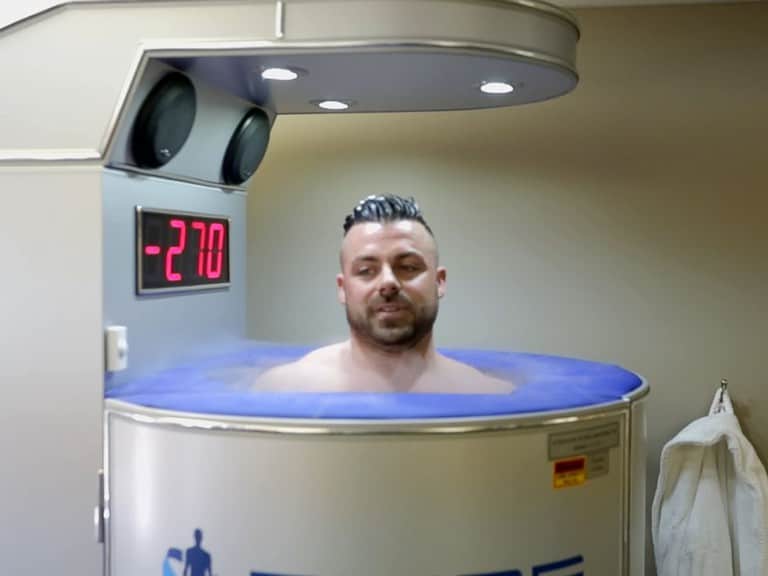Can Cryotherapy Be Dangerous? Discover the Potential Risks.
Cryotherapy has been gaining in popularity as a way to reduce pain, inflammation, and improve overall health. But can cryotherapy be dangerous? The answer is yes – while offering numerous potential advantages, there are some risks that must be taken into account prior to engaging in this form of therapy.
To answer the question, “can cryotherapy be dangerous?” In this article, we will explore what cryotherapy is, the potential risks and side effects of the procedure, who should avoid it altogether, and how to minimize risk when undergoing treatment. We’ll also discuss whether or not these dangers outweigh the potential rewards for those considering taking part in cryotherapy treatments.
Table of Contents
What is Cryotherapy?
Cryotherapy is a modern therapeutic technique that uses cold temperatures. Cryotherapy helps to promote healing and reduce inflammation. Also, cryotherapy helps to benefit both physical and mental well-being, such as augmented sleep quality, increased athletic proficiency, alleviation of pain sensations, lowered stress levels, and more. There are several types of cryotherapy available to suit individual needs.
Cryotherapy is a therapeutic approach involving subjecting the body to very cold temperatures with the aim of activating healing mechanisms. Cryotherapy utilizes temperatures from -110°C (-166°F) to -140°C (-220°F), providing a cooling effect on the affected area. This process helps reduce inflammation and swelling by constricting blood vessels near the surface of the skin which reduces circulation around affected areas.
(Source)
The potential advantages associated with cryotherapy are manifold, ranging from decreased post-exercise muscle soreness to increased metabolism and improved sleep quality. Athletic performance may also be enhanced through the use of this technique, while anxiety levels can be significantly reduced. Furthermore, joint pain caused by arthritis or other conditions can potentially be alleviated; collagen production may even be stimulated in order to promote smoother skin texture.
Lastly, some individuals have reported weight loss due to an increase in caloric burn during treatment sessions.
Is cryotherapy dangerous? Before you undergo cryotherapy of any type, it is important to be aware of the potential risks and side effects. It is critical to speak with a medical practitioner prior to initiating any form of cryotherapy.
With that in mind, let us now explore the potential risks and side effects associated with cryotherapy.
Potential Risks and Side Effects of Cryotherapy
Before you undergo cryotherapy in cryotherapy spas, it is important to be aware of any potential risks and side effects associated with the procedure. It’s important to understand the short-term, long-term, and contraindications associated with cryotherapy so you can make an informed decision about whether or not it’s right for you.
Cryotherapy may lead to sensations of irritation, redness, numbness, tingling, or temporary puffiness in the region being treated during and after a session. The treated area may experience a temporary increase in swelling that can be resolved within several hours.
Long-Term Side Effects
There have been reports of more serious long-term side effects such as tissue damage due to extreme cold temperatures used during cryotherapy sessions. Potential harm may arise if exposed to frigid temperatures for an extended duration, such as frostbite.
People suffering from Raynaud’s syndrome, peripheral neuropathy, and cardiovascular disease should steer clear of cryotherapy as it could worsen their condition. Pregnant women and children should also avoid this type of therapy due to a lack of evidence regarding safety in these populations. Those who have sensitive skin or allergies should use caution when considering this type of therapy since they may be more prone to reactions from exposure to extreme cold temperatures used during cryotherapy sessions.
Overall, while cryotherapy chambers offer many benefits it is important to weigh out all possible risks beforehand in order to ensure your safety and well-being when considering using this form of therapy.
It is essential to evaluate the possible dangers and adverse reactions of whole-body cryotherapy sessions before deciding if it is suitable for you. Weighing the potential advantages against any possible dangers or contraindications that could make this treatment hazardous is essential before making a decision.
Moving on, let’s look at who should avoid cryotherapy altogether due to certain medical conditions, age groups, or skin sensitivities.
Who Should Avoid Cryotherapy?
Whole-body cryotherapy is a popular wellness treatment that can offer many health benefits. However, it’s important to note that not everyone should use this therapy. People with certain medical conditions, pregnant women and children, and those with sensitive skin or allergies should avoid cryotherapy.
Individuals with specific medical conditions, such as hypertension, cardiac issues, breathing troubles, or other serious ailments should not undertake cryotherapy without prior authorization from their doctor. Cryotherapy involves exposing the body to extremely cold temperatures which can put additional strain on the cardiovascular system and could worsen existing medical conditions. It’s best for people with pre-existing medical issues to get clearance from their physician before undergoing cryotherapy treatments.
Pregnant women should exercise caution when considering cryotherapy, as exposure to extreme cold temperatures during pregnancy may carry certain risks. Young people aged below 18 are usually not allowed to have cryotherapy since they may be more sensitive than grown-ups when exposed to such low temperatures for a long time.
For those with eczema or psoriasis, cryotherapy can exacerbate symptoms due to dryness and irritation from the cold air during sessions. Additionally, individuals who have allergies should also avoid this type of therapy as it could trigger an allergic reaction due to inhaling particles in the air used during treatments (e.g., liquid nitrogen).
In summary, while there are many potential benefits associated with cryotherapy treatments – including improved circulation and enhanced recovery after exercise – some people should take extra precautions before trying out this type of therapy.
It is essential to be aware of who should steer clear of cryotherapy due to the potential cryotherapy side effects. It is also essential to observe safety regulations and take precautions when utilizing cryotherapy, so as to reduce the chances of harm or negative consequences.
How to Minimize the Risk of Injury from Cryotherapy?
Cryotherapy, a long-employed treatment employed for numerous medical and health purposes, has become increasingly popular as a wellness therapy. While it can be beneficial, there are risks associated with this form of therapy and it’s important to understand how to minimize the risk of injury when using cryotherapy.
Following safety guidelines and precautions is one way to reduce the risk of injury from cryotherapy. Always heed the instructions given by your doctor or therapist when receiving any type of cryotherapy treatment to reduce the risk of injury. It is essential to wear appropriate apparel, including gloves, eye protection, and long-sleeved garments if necessary when receiving any form of cryotherapy.
It’s also important to ensure that the equipment being used is properly sanitized before each use in order to prevent cross-contamination between patients.
It’s also essential to consult a professional before using whole-body cryotherapy since some conditions may require additional safety measures or even preclude its use altogether. For example, pregnant women and children should avoid cryotherapy treatments due to the potential risks posed by extreme temperatures on their developing bodies.
Additionally, those with certain medical conditions like heart disease or high blood pressure may need special consideration when undergoing any type of cold therapy treatment due to possible side effects caused by changes in temperature levels within their body systems.
Finally, monitoring your body’s response during each session can help minimize the risk of injury from cryotherapy treatments as well as identify any potential adverse reactions early on. Be sure to pay attention during each session and take note afterward too – whether it is feeling extra soreness after an intense session or experiencing headaches shortly after.
Should any adverse reactions be noticed, like aches and pains post-treatment or headaches soon after, a physician should be consulted to ascertain the cause of these symptoms and treat them as necessary.
FAQs in Relation to Can Cryotherapy Be Dangerous
Who should not use cryotherapy?
Cryotherapy should not be utilized by those with specific medical issues, including hypertension, cardiovascular disease, and blood flow problems. It is not advised for those who have recently undergone surgery or experienced trauma in the area being treated, as well as pregnant women and minors. Those taking medications that affect circulation should also avoid cryotherapy.
Before beginning cryotherapy, it is important to consult a doctor if you have an underlying health condition or are unsure of its suitability.
Can cryotherapy cause permanent damage?
Is cryotherapy dangerous? Yes. Can body cryotherapy treatments in a cryotherapy chamber cause permanent damage? No, cryotherapy does not cause permanent damage.
Cryotherapy, which uses cold temperatures to address medical issues such as inflammation and pain relief, is generally safe when performed by an experienced practitioner. The extreme cold temperatures used in the therapy can cause temporary side effects such as skin irritation or numbness, but these usually resolve quickly once the session has ended.
When done correctly and with appropriate safety measures, cryotherapy should not cause any lasting damage.
What are the 3 effects of cryotherapy?
1. Improved Blood Flow
Medical cryotherapy has been shown to boost the circulation of oxygen and nutrients, thus improving healing and recovery from injury or physical activity.
2. Pain Relief
The extreme cold temperatures associated with medical cryotherapy can help reduce inflammation, which in turn helps alleviate pain caused by chronic conditions such as arthritis or fibromyalgia.
3. Stress Reduction
Studies have shown that regular body cryotherapy sessions can lead to reduced levels of stress hormones like cortisol and adrenaline, helping people feel calmer and more relaxed overall.
Can cryotherapy cause blood clots?
No, cryotherapy does not cause blood clots. Cryotherapy is a therapeutic method that employs cold temperatures to reduce inflammation and discomfort. For years, cryotherapy has been employed as an alternative healing method with hardly any noticeable adverse effects.
Though there have been a few accounts of individuals developing thrombosis following cryotherapy sessions, these occurrences are exceedingly rare and the root cause is unknown. Therefore, it cannot be definitively said that cryotherapy causes blood clots.
Conclusion
In conclusion, cryotherapy is a popular form of treatment that can provide many health benefits. It is therefore essential to weigh the potential risks and side effects associated with cryotherapy before deciding if it is suitable for you. Cryotherapy, when utilized properly and overseen by a qualified expert, is generally secure; yet for certain people, it ought to stay away from altogether as abuse or misuse could bring about serious results.
By following safety protocols and taking precautions such as monitoring your body temperature during sessions, you can reduce the risk of injury from cryotherapy – proving that while yes indeed “can cryotherapy be dangerous”, in most cases when used responsibly it doesn’t have to be.
Discover the facts about cryotherapy, how it can benefit your health, and any potential risks associated with this therapy. Take control of your wellness journey by exploring our comprehensive resources to make Smart Living Now a reality.







